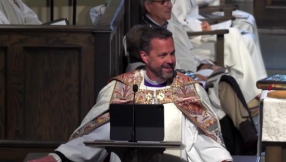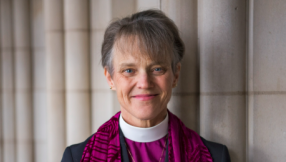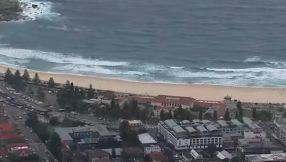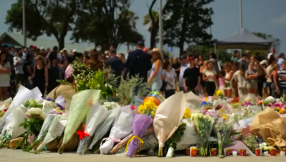Motivation
For all the imposing scale of the completed canvas, the first sketch was little more than a doodle on a scrap of paper. Picasso was motivated, somewhat reluctantly, by an open-ended commission from the Spanish Government to make a large painting for their national pavilion in the prestigious 1937 Paris Expo. They had even provided a craftsman to build the frame and stretch the canvas. Spain's newly elected Nationalist Government was feeling ambitious. It sent a flattering deputation to Picasso, who then struggled to get started. After working without conviction on several themes – the still-life group, the model, the artist in the studio, etc. – he heard news of a shocking development in the Civil War. The sketch marked a turning point in his output.
By April 1937, Picasso’s homeland was in its tenth month of war. Each side had seen gains and losses; each had accused the other of war crimes. During the afternoon of the 27 April disturbing rumours began to circulate that Guernica, a town in the Basque country, had been flattened. It was market day; many farmers from the surrounding countryside were carrying out their weekly trade. The town had no military significance, although it was seen as the symbolic heartland of Basque 'national’ identity. The following day, French papers carried photographs and eye-witness accounts. 1,645 were reported dead; nearly a thousand wounded.[1]
Picasso produced his first hasty sketches on 1 May. Over the next five weeks, not only had he completed the painting, but also generated a large number of preparatory studies. The impressive output has survived as a unit. It now fills three rooms in the Reina Sofía. Like the painting itself, most of the studies are carried out in black, white and shades of grey, reflecting the huge psychological impact of the newspaper coverage. On display with the work is a series of photographs that record the painting’s development. In the same galleries are two sculptures and other studies that, whilst standing outside the five-week time frame, contain strong thematic links with the painting. It is a remarkable record of the process that led to the creation of a great work of art. For all this, Guernica remains an enigmatic piece, which is open to wide interpretation in almost every detail.
Meet the characters
The huge canvas contains nine characters. Three of these – a kneeling women, a fatally wounded horse and a fallen warrior – occupy the foreground. Together they create a classic triangular structure. The base of the triangle runs along the whole of the bottom edge, whilst the apex reaches the top of the painting.
Outside the triangle, two more women fill the space to our right. The one on the far right flings her head and hands skywards whilst closer in, the other leans from a window. Her elongated right arm enters the top of the main triangle where she clasps a lamp that is illuminated by a small flame. To the left is an electric light. Its bulb is framed in a shallow lampshade, reflecting light downwards in jagged rays, which stop abruptly near the horse’s head.
The remaining area on our left is dominated by a bull. In front of the bull, a women is holding a dead child. Her head too is tilted upwards, her mouth contorted with grief. Behind the bull, a small bird is hidden away in the darkness. Like the women at each edge of the painting, its head is also thrown back, crying out to the heavens from a table hard against the back of the room. Space is highly constricted throughout the canvas. The claustrophobia is enhanced by a pattern of contrasting lights and darks. The background, of ambiguously related internal and external walls, compounds this.
The commission came at a time of high emotional ambiguity in Picasso's life. Dora Maar, the photographer who captured Guernica through its different stages, was also his lover, a position she reluctantly shared with Marie-Thérèse Walter. The Tate gallery has paintings of both women. They are often hung within sight of each other. Both women appear again in Guernica: Dora as the model for the two anguished women, Marie-Thérèse for the two fluid-limbed witnesses who look on in horror.
It is not my idea to give this meaning
Ambiguity is a hallmark of much of Picasso's work. He rarely makes the interpreter's life easy. When asked to explain the bull or the horse, he insisted on the primacy of image over interpretation:
. . . this bull is a bull and this horse is a horse . . . if you give a meaning to certain things in my paintings it may be very true, but it is not my idea to give this meaning.[2]
If this leads us to believe he didn't care about the content, it is deceptive: he was,
appalled at the explosion of hatred that occurred in Spain . . . sometimes, when he thought he was alone, Dora Maar heard him heaving sighs which sounded like groans.[3]
The extensive eclecticism woven into Picasso's work makes it difficult to pick out a dominant philosophy. He seems to have viewed art as his contribution to the ongoing fight to make sense of life. ‘Painting is not done to decorate apartments,’ he asserted. ‘It's an instrument of war for attack or defence against the enemy.'[4] Seeing life as a heroic fight is an attitude which is easily aligned with the existentialism of friend and philosopher, Jean-Paul Satre. The artist's willingness to embrace life and to back his own creative judgment demonstrates, however, a joie de vivre that is a long way from the introspective uncertainties of the movement's leading novelist. The Nietzchian portrait of the artist as Dionysian ‘superman’ is much closer.
Politically, anarchism and communism both put in an appearance. We need go no further than George Orwell's animated account of his brief career in the Spanish Civil War to know how desperately they could clash.[5] Picasso experienced the movements in situations that differed greatly from each other, and from that of Orwell.
Anarchism was an overt attraction during his formative days in Barcelona.[6] It was mediated through a social group for whom the ‘renaissance’ of Catalonian culture, as exemplified by the Modernista movement, was the main driving force.[7] Anarchism seemed a natural home for anyone interested in regional autonomy, and it would have suited Picasso's journey away from the strictures of the Madrid Academy toward the ever-increasing creative freedom that he was soon to discover in Paris.
Communism was the one serious contender for Picasso's political loyalty. The Spanish government was supplied with arms by the Soviet Union, which was the only foreign power to give material support to the Nationalist cause, albeit at a price. In the end, this support proved a mixed blessing.[8] For those who, like Picasso, were horrified by the growth of a militarised Fascism, it encouraged a somewhat uncritical embracing of both Soviet propaganda and communist ideals. Picasso had more personal reasons for eventually joining the French Communist Party. Long-standing friendships and social networks were of greater importance than ideology.
Internationally, capitalists and communists alike found fault with Guernica and its creator on the spurious grounds that it, or he, seemed closer to their antagonist's values than to their own. As Françoise Gilot, his partner from 1943–1953, explained, 'In Russia they hated his work but liked his politics. In America they hated his politics but liked his work,’ adding Picasso's own take on things: ‘I am hated everywhere, I like it that way.'[9]
Native Soil
Picasso was always his own man. Few alliances, be they romantic, artistic, philosophical or political, could deflect his vision. The great constant was his identity as a Spaniard. Like the proverbial cat, Spain is a nation that walked alone. Standing slightly apart from other European countries it developed its own particular culture, often through violent conflict. Paradoxically his artistic lineage is frequently traced by reference to precursors in French art.[10] This is only part of the story. To analyse the thought processes behind Guernica, it is important to see how rooted they are in his native soil.
The rhythms of the bullfight are typically Spanish. The horse appears in the opening phase. Its task is to support a rider, the picador, who will drive a lance into the bull's neck to begin the process of tiring the bull. Horse and rider then leave the ring. Enthusiasts know what to expect.
Picasso was an enthusiast but he changes the script. In Guernica it is the bull which becomes an onlooker whilst the horse takes centre stage. The horse is collapsing on a fallen warrior. A spear is lodged in its body; another lies broken beneath it; there is a stigmata shaped gash in its side. From the development of this theme throughout the studies, it is apparent that the horse and the human have tragically wounded each other. This unexpected change of roles transforms the ritual into a macabre parable of civil war.[11]
Political Protest?
From the sphere of Spain’s historical painting, the wounded animal brings to mind Goya's The Second of May, 1808 (Uprising). The painting commemorates the start of the fight back against the Napoleonic occupation. Hanging next to it in the Prado is The Third of May, 1808 (Execution). It shows a defenceless group of civilians being shot down by an anonymous firing squad. Our attention is captured by the gesture of one of their victims, a white-shirted man who faces them. Both his arms are raised in an emphatic ‘V’ shape of helpless appeal. In Guernica the woman to our far right is portrayed as if suspended in mid air. Her arms, too, are thrown into a ‘V.’
In the hands of politicians, activists and private citizens, Guernica is swiftly adapted as an appeal against a range of perceived injustices. Hensbergen notes how, during the Franco era, supporters of democratic change quietly replaced their replicas of da Vinci's Last Supper with reproductions of Guernica. [12]In the introduction to his book on Guernica, by way of contrast, he recounts how the full-size tapestry of the painting at the UN was ‘ignominiously’ covered, in the lead-up to the Iraq War, to prevent its ironic appearance in press briefings, despite it being a well-known part of the UN's education programme.[13]
Journalist Danny Woods reminds us of its political cache in the post-Franco era. He quotes Javier de Blas, a senior curator at the Reina Sofía, who says, ‘The whole world accepted that the country had recovered its political and social liberties in part because Picasso permitted the return of the painting to Spain.’[14] The artist had refused to do this whilst Franco was still in power. It was a gesture that gave voice to layers of accumulated pain at the start of a slow and faltering therapeutic process.[15]
Iconography of Suffering
The Prado contains a wealth of precedents for the ‘V’ shaped arms. Here, amongst the assembly of work by Spain's greatest artists, are a number of large-scale crucifixions. Goya's own mature contribution to the theme is a slightly romanticised example of this, but many of his predecessors, including his own earlier treatment, have a less dewy-eyed view of this painful and bloody spectacle. Zurbar's Crucifixion with St Luke is one example, with even the shape of the hands anticipating the Guernica women.
Spanish artists inhabited a tradition which took great care over the portrayal both of Christ's sufferings and of his mother's sorrow. The images of his unstaunched blood and bruised face speak of his Passion; the tears and harrowed expression, of Mary's grief. The message is simple: this looks real because it was real.
Picasso's studies of ‘the weeping women’ and the mother carrying her dead son tap into a strand of ‘Marion’ spirituality that is grounded, however tenuously at times, in the biblical narrative. When Simeon tells Mary that, ‘a sword will pierce your own soul too’ (Luke 2:35), it is clear that she is to be irrevocably identified with the suffering of her son. Picasso knows how powerful this image is for the psyche of Spanish people. Its grip on their religious imagination is clearly paraded in the statues that decorate their churches and street fiestas, as well as in their great art collections.
John Moffatt identifies Andalucia as the region that nurtured this devotional practice.[16] One such sculpture is on display in Picasso's birthplace, now the Picasso Foundation in Malaga, in a room which replicates both his father's studio and craftsmanship. From exile in Paris, Picasso activates the pathos of this language to identify with the suffering of the nation.
Picasso labeled himself an atheist. But, when it came to symbolising the events of his homeland, he instinctively draws on this native iconography of faith and suffering. Such instincts are more profound than the cheerful sentimentality of his compatriot, Murillo, and far deeper than the superficiality of those critics who find only irony in his re-use of Christian imagery. Later work, including the sculpture of a shepherd holding a lamb, which is displayed alongside the Guernica studies in the Reina Sofía, suggest a greater warmth toward Christian sources. Attempts to ground Guernica in a purely secular worldview are easily subverted.
Voice of Lament
The theologian and musician Jeremy Begbie would not be surprised. The main thesis of his book, Sounding Creation's Praise, is that a central function of art is to give voice to the silent praise which creation offers its creator.[17] Building on both ‘Reformed’ and ‘Liberal Protestant’ lines of argument, Begbie holds that great art may achieve this, even when it is not consciously Christian. Guernica fulfills a spiritual need of a different kind - the need for lament.[18] The two anguished women and the ‘stigmata’ slash in the horse, provide us with strong clues that this is intentional.
The Christian references in Guernica principally come from the hours immediately around and following Christ's death. It is the time when the anguish of the crucifixion is followed by the uncomprehending grief of Jesus' disciples. As a painting, Guernica is full of cries and grief-filled questions – before it is ever an act of protest, an opportunity for politics, a visual aid for peace studies or, even, a means of healing.
The painting works as a highly nuanced metaphor. The artist travels through many levels of visual invention and associations from art history until finally inviting his original viewers to identify the sufferings of the Spanish people with the sufferings of Christ and the pre-resurrection desolation of those closest to him. Lament always pre-dates resolution, but it is not without hope.
The Apostle Paul urges us to see our inability to make sense of things, especially of suffering, in the context in which all creation is groaning as it awaits a final answer (Romans 8: 20–26). Seen in this light Dora Maar may have witnessed more than she realised when she overheard Picasso ‘heaving sighs which sounded like groans’ over Spain’s plight.
Stimulated by a specific tragedy, Guernica is a painting which came to birth as a complex metaphor for the Spanish Civil War before becoming an international talisman for a diverse range of causes. It can also be viewed as a continuation of the long, deep note of human lament that resonates down history as people ‘try to pray’ in the midst of inexplicable suffering.
This article was first published on Damaris' Culturewatch website (www.culturewatch.org) - used with permission.
© Copyright Stuart Goddard 2008

--------------------------------------------------------------------------------
[1] Antony Beevor, The Spanish Civil War (Orbis Publishing Ltd., 1982) ref p. 243 in the Cassell's Military Paperbacks 1999 edition. For a nuanced interpretation of these figures see Mark Kurlansky The Basque History of the World (Jonathan Cape 1999) p. 200. Wood’s article (see below) gives much lower casualty figures than Beevor or Kurlansky. Kurlansky discusses the potential for discrepancies, upholding the general trustworthiness of the Basque Government’s higher estimates.
[2] Quoted in ‘Questions of Meaning’, in ‘Treasures of the World’, PBS.org, last accessed 12 November 2008.
[3] Jean-Paul Crespelle, Picasso and his Women (English translation – Hodder and Stoughton, 1969, first published in French, 1967).
[4] Quoted in Gijs van Hensbergen, Guernica: The Biography of a Twentieth-Century Icon (Bloomsbury, 2004), p. 25.
[5] George Orwell, Homage to Catalonia (Penguin, 1986, first published in 1938). The last three chapters of the Penguin edition, give a very readable picture, whilst the two chapters which appear as appendices offer analysis of the political complexities. This edition includes useful ‘notes on the text’ by Peter Davison and ‘introduction' by Julian Symons.
[6] Gertje R. Utley, ‘From Guernica to The Charnel House' in Stephen Nash (ed.), Picasso and the War Years: 1937–1945 (Thames and Hudson, 1998) p. 69.
[7] See John Richardson, A Life of Picasso, Vol 1: 1881-1906 (Jonathan Cape, 1991), especially chapters 8 and 9.
[8] Antony Beevor, The Spanish Civil War (Orbis Publishing Ltd., 1982) ref ch. 13 in the Cassell's Military Paperbacks 1999 edition.
[9] Quoted in Hensbergen, Guernica, p. 198.
[10] See the introduction in Jonathan Brown (ed.), Picasso and the Spanish Tradition (Yale University Press, 1996).
[11] Of course, bullfights do not always go to plan. For example, a series of four photographs show a frightened horse unseat, then roll on, its picador before receiving a goring (see Herschel B .Chipp, Picasso’s Guernica (Thames & Hudson, 1989) ch. 5 (photos copyright Editiones Polygrapha (S.A., Barcelone, 1991), seen in the 1992 French edition). What is unexpected is that almost nowhere, either in the studies for Guernica or in the painting itself, is the bull implicated in the mutual harm done by horse and rider.
[12] Hensbergen, Guernica, p. 237.
[13] Hensbergen, Guernica, pp. 1–2.
[14] Danny Wood, ‘The legacy of Guernica’, bbc.co.uk, 27 April 2007, (last accessed 26 November 2008).
[15] For an analysis of just how slow, see the opening chapters of Giles Tremlett, The Ghosts of Spain (Faber & Faber, 2006).
[16] John Moffitt, The Arts in Spain (Thames and Hudson, 1999) p. 134.
[17] Jeremy Begbie, Sounding Creation's Praise, (T&T Clark, 1991).
[18] Discussion of lament as a neglected aspect of church life can be found in Simon P. Stocks, Using the Psalms for Prayer Through Suffering (Grove Books, 2007) and Paul Bradbury, Sowing in Tears; How to Lament in a Church of Praise (Grove Books, 2007).













